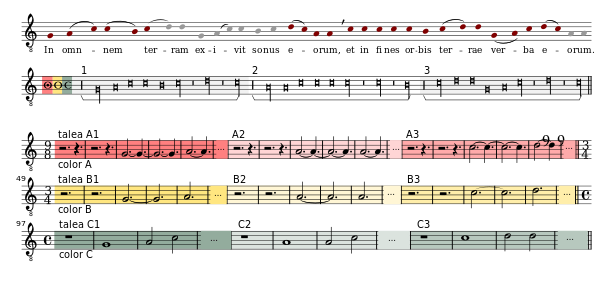Izorytmia

Izorytmia (z gr. równy rytm) – technika kompozytorska, która pojawiła się we Francji w XIV wieku. Opisana jest w traktacie Ars nova Filipa de Vitry (ok. 1320). Polega na zastosowaniu tzw. ordo – periodycznego powtarzania schematu rytmicznego (czyli tzw. talea) i melodycznego (color) lub tylko jednego z nich. Rytmikę izorytmiczną stanowiło 6 modi – schematów rytmicznych opartych na greckich stopach metrycznych.
Zjawisko stosowane było już w najstarszym gatunku wielogłosowej muzyki europejskiej, czyli w organum ze szkoły Notre-Dáme. Najpopularniejszym gatunkiem, w którym wykorzystywano technikę izorytmiczną, był motet (nazywany stąd motetem izorytmicznym).
Wyróżniamy (chronologicznie) izorytmię niekompletną (swój modus posiadał tylko tenor) i kompletną (czasami zwaną pangizorytmią) – gdy każdy głos uporządkowany był według modus. Technika ta miała fundamentalne znaczenie w historii muzyki. Z nią związane jest powstanie notacji menzuralnej, przyniosła ona też takie środki kompozytorskie w zakresie technik imitacyjnych jak augmentacja i jej przeciwieństwo – dyminucja, ale przede wszystkim późniejsza muzyka przejęła istotę tej techniki: powtarzalność schematów rytmicznych i melodycznych. Zaczęto tym samym zwracać uwagę na jednolitość materiałową kompozycji.

Bibliografia
Media użyte na tej stronie
Tenor del Kyrie I dalla Messa di Guillaume de Machaut
Autor: Future Perfect at Sunrise, Licencja: CC BY-SA 3.0
Structural diagram of the isorhythmic tenor of a late 14th century motet of the Ars Nova, "Sub arturo plebs – fons citharizantium – in omnem terram", by John Aleyn (Alanus), featuring threefold isorhythmic diminution.
- First staff: preexisting Gregorian cantus firmus melody, from the first antiphon for the first nocturn of the commons for Apostles, "In omnem terram exivit sonus eorum" ('their voice has gone out into all the world'). Melody transposed one fifth up; notes used for the tenor marked in red.
- Second staff: Isorhythmic tenor as notated in mensural notation. Numbers 1-3 and brackets indicate three rhythmically identical sequences (taleae). The three mensuration signs in the beginning define the pattern of diminution, indicating "tempus perfectum cum prolatione maiore, tempus imperfectum cum prolatione minore and tempus imperfectum cum prolatione minore, respectively. (In the manuscript these signs are in fact found at the end of the line, together with a repetition sign.)
- Staves 2-5: Abbreviated transcription into modern notation. Each line represents one full repetition of the tenor (color), including the three talea in each, resulting in a nine-part structure. (Within each color, only the first few notes of each talea are rendered here.) The three mensuration signs in the line above correspond to the change in time signatures (9/8, 3/4, 2/4). In each color, the duration of each note is shortened by a factor of 2/3.

